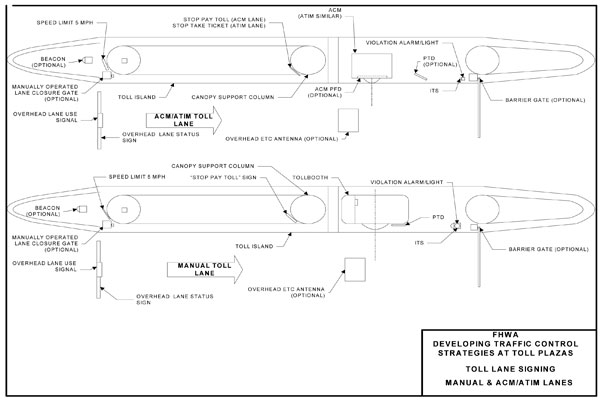Toll Lane Signing Design Issues
Toll Lane Signing Guideline Development:
Although use of the toll industry standard modified stop sign stating “Stop Pay Toll” may not be afforded the same level of compliance among ETC accountholders, deployment of this sign in the cash lanes should continue to reinforce the user’s statutory responsibility to pay the indicated toll. This applies equally to the “Stop Take Ticket” sign commonly deployed in the ATIM lanes of a closed ticket system. Users of a ticket system, including those without a valid transponder or ETC account, are given reasonable notice to initiate a toll transaction at their entry location by taking a ticket to avoid payment of a toll based on the furthest entry point from their exit location.
The location of toll lane signing on the toll island must be selected to result in the user consistently responding at the intended location along the lane. Speed limit signs need to be installed at the approach end to the toll island with the expectation that the user will adjust their speed to comply with the speed limit when traveling through the lane. If speed display signing is deployed, it should be located in conjunction with a speed limit sign to elicit a quicker response from the user to comply by reducing the vehicle’s speed as needed when traveling through the lane. The modified stop sign commonly used by the agencies should be installed at the approach end of the tollbooth in the manual lanes. For the automatic lanes, the modified stop sign should be installed on the toll island prior to the ACM or ATIM, mounted to a canopy column or other physical feature, if available. For multi-payment type lanes that are operated in an ETC only mode, a speed limit sign should be installed in the lane, particularly when a collector must cross these lanes to access their assigned tollbooth. In this case, an ETC user complying with the “Stop Pay Toll” sign may be inclined to quickly accelerate from the booth or machine when exiting, which is where the collector typically crosses the lanes. Signing related to equipment installed on the toll island should be attached to or installed adjacent to that equipment. Any “No Stopping” signs should be installed in an ETC dedicated lane prior to where the user recognizes there are no provisions for cash payment in the lane. The “Stay in Vehicle” sign should be installed above the ACM or ATIM. The selected location of these signs must assure visibility to all passenger car and trucks allowed to use the particular lane. The diagram at the end of this section shows the location of some of the signs described above.
With an assumed window of 6-18 inches representing a conservative range for horizontal clearance from the travelway used within the toll industry, 12 inches provides an appropriate clearance for protecting toll lane signing from extended mirrors and objects or materials extending beyond the side of a vehicle.
Before adding toll lane signing such as “No Stopping” in the ETC dedicated lanes, “Stay in Vehicle” in the ACM/ATIM lanes, “Enforcement by Video” or a related camera based enforcement message in lanes deploying VES equipment, and “Wait for Green”, the agency should make an assessment of the magnitude of the problem the particular sign is intended to address along with the particular user benefit derived from the sign.
Toll Lane Signing Guidelines
| Guideline | Toll Lane Signing Guideline 1 |
| Title | Stop Signs |
| Text | Stop signs should be deployed in cash toll lanes to require all users to stop to either pay a toll or take a ticket. A standard stop sign above a plaque containing supplemental information (e.g., pay toll, take ticket) or a modified stop sign stating “Stop Pay Toll” should be installed in the manual and ACM lanes and “Stop Take Ticket” should be installed in the ATIM lanes. |
| Commentary | A compliant ETC user in a multi-payment type lane is not expected to be inconvenienced by stopping in the cash lanes, even though the island traffic signal may display a green state when observed by the user. |
| Guideline | Toll Lane Signing Guideline 2 |
| Title | Speed Limit Signs |
| Text | Speed limit signs should be installed at the approach end to the toll island for all ETC dedicated lanes. |
| Commentary | Although deployment of speed limit signs in conjunction with stop signs should be avoided, where speed display signs are deployed in particular cash lanes because of excessive toll lane entry speeds, a speed limit sign should be installed in conjunction with the speed display sign. |
| Guideline | Toll Lane Signing Guideline 3 |
| Title | Miscellaneous Signs |
| Text | Deployment of miscellaneous signs should be based on an assessment of the particular problem the sign is intended to address or the value of the benefit derived by the user from the information the sign provides. |
| Commentary | None |
| Guideline | Toll Lane Signing Guideline 4 |
| Title | Sign Horizontal Clearance |
| Text | A horizontal clearance of 12 inches should be used from the face of the toll island or raised barrier to the nearest edge of the sign or display. |
| Commentary | None |

Exhibit 3-9 Toll Lane Signing
Table of Contents | List of Tables | List of Figures | Previous Section | Next Section | HOME